
Abandoned & Little-Known Airfields:
New Mexico: Alamogordo area
© 2002, © 2024 by Paul Freeman. Revised 11/20/24.
This site covers airfields in all 50 states: Click here for the site's main menu.
For a 4th year, the NM pages of this website are sponsored by the New Mexico Pilots Association:
____________________________________________________
Please consider a financial contribution to support the continued growth & operation of this site.
(Original) Alamogordo Airport / Alamogordo Field (revised 3/8/20) - Condron AAF (revised 11/20/24) - Northrup Strip / White Sands Space Harbor (revised 5/11/21)
Oscura AAF (revised 11/23/20) - Sunspot Heliport (added 9/28/14) - Tularosa Airport (added 2/28/14) - White Sands Airport / Alamo Midway Airport (revised 11/6/22)
___________________________________________________________
Condron Army Airfield (KWSD), White Sands, NM
32.338, -106.404 (South of Albuquerque, NM)
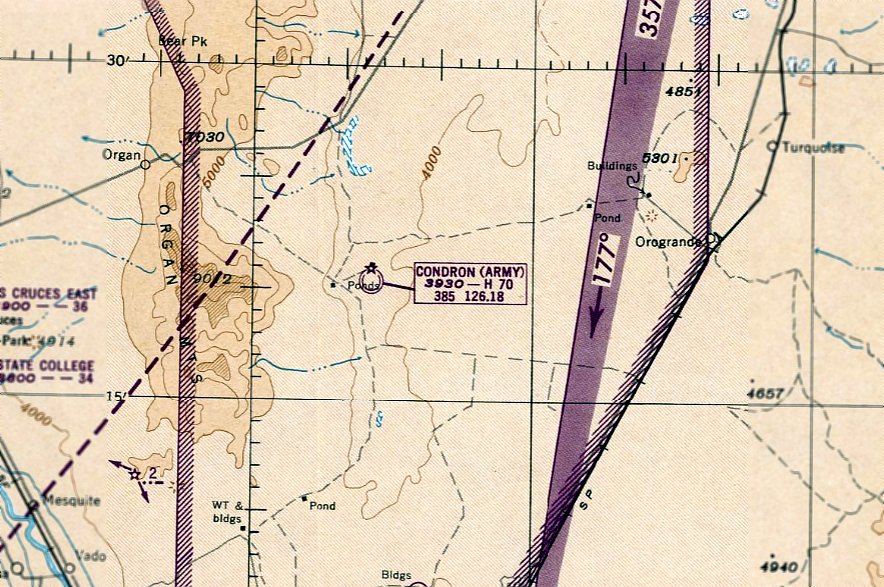
Condron Army Airfield, as depicted on the September 1948 Roswell Sectional Chart.
The Army's huge White Sands Proving Grounds was established in 1945,
and has been used to test nearly every missile system in the US inventory
(as well as being the location of the original atomic bomb detonations).
White Sands is the largest military installation in the US, encompassing more than 4,000 square miles.
Condron Army Airfield is is located on the southwest corner of White Sands,
and is one of several airfields within the Proving Grounds.
Condron AAF's specific purpose in supporting the testing activities conducted at White Sands has not been determined.
It was apparently built at some point between 1947-48,
as it was not depicted on the September 1947 Roswell Sectional Chart.
The earliest depiction which has been located of Condron AAF was on the September 1948 Roswell Sectional Chart.
It depicted “Condron (Army)” as having a 7,000' paved runway & a control tower.
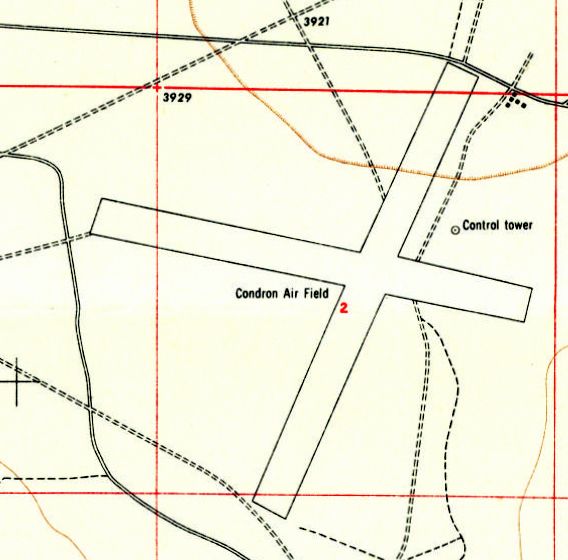
The 1948 USGS topo map depicted “Condron Air Field” as having 2 runways, with a control tower to the northeast of the runway intersection.
According to Wikipedia, in March 1949, Holloman AFB's 2,754th Air Force Base unit gained control
of the White Sands Proving Ground support airfield, Condron Field, from Biggs Army Air Field.
Mike Marson recalled, “Tom Marson was Civil Air Patrol in the mid 1950s to 1960.
He was a flight instructor & worked as a civilian engineer for the DoD at White Sands.
Most of his instruction was done flying out of Condron.
I was a boy who spent most of my time there on the ground looking for something interesting to play with amongst the castoffs of the 1 or 2 hangars on the site in the early 1960s.”
Tom Marson recalled, “I had my regular 'day job' at White Sands as an Equipment Specialist Missile engineer. Each day our carpool passed a short distance from Condron.
While at work one of the men in our group, an Army Captain, heard I had a Certified Flight Instructor rating
and asked me to start giving instruction to White Sands Missile Range Flying Club members after work & on weekends.
He told me that the Club Manager & CFI, Major Doty was overloaded with students. There was another instructor also a civilian named Dryden.
There were so many students that getting instruction was often hard to schedule.
We had 2 'civilian' planes, a PA-11 90hp & a 125hp Super Cub. In addition there were several ex-military government-owned planes.
I remember 2 Cessna 195s, 2 Navions, later we acquired 2 Beech C-45s (one was for spare parts).
These Beeches were surplus from the U.S. Public Health service. The civilian number of the operational C-45 was N9114R.”
Tom continued, “We had one full-time mechanic to keep our planes operational; his first name was Frank.
After a time Major Doty retired & Bob Dryden left too. I became Operation Manager & Chief (& only) Flight Instructor.
We had lots of folks who took multiengine instruction in the C-45. About 12-15 men received multiengine ratings under me.
Condron Field had 2 very very wide caliche (packed-dirt) runways. I almost never saw visiting military planes there (probably 2-4/month).
Those I saw were not large: several Beavers & mid-size twins.
I remember one trip was from Condron to Huntsville AL, a long trip for a Beaver.”
Tom continued, “In my 5 year period from 1958-64 I had maybe 50-80 students flying out of Condron Field.
In checking my records I recommended around 18 students for Private Test, 4 for Commercial, 8 Mulitengine and one Flight Instructor.
The one CFI was a Military Instructor from Holloman AFB wanting to be receive his FAA Civil License. My students had a 100% passing rate.
I instructed the only female student that ever flew as part of the WSMR Flying Club as far as I knew.
I did not know of any instructors or student who flew there who were not employed at WSMR, either contractor, Military personnel or civilian government employees.
The exception is that dependents of personnel who lived on the base could become members of the WSMR Club.
I never saw any planes at Condron Fied that were not assigned to our WSMR Flying Club or visiting military.”
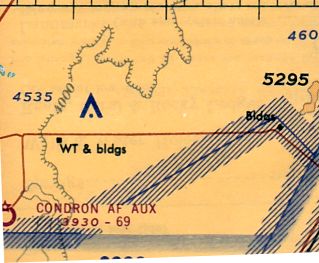
The June 1965 Roswell Sectional Chart (courtesy of Ron Kunse) depicted “Condron AF Aux” as having an unpaved 6,900' runway.
Kevin Wells recalled, “Condron Field... I was one of the students there, studying under Carl Hittle.
I soloed cross country twice; I was stationed there in the Army.”
According to the book “The Praetorian STARShip: the Untold story of the Combat Talon”, Condron AAF was used in 1980 to test specialized versions of the AC-130 & MC-130 aircraft.
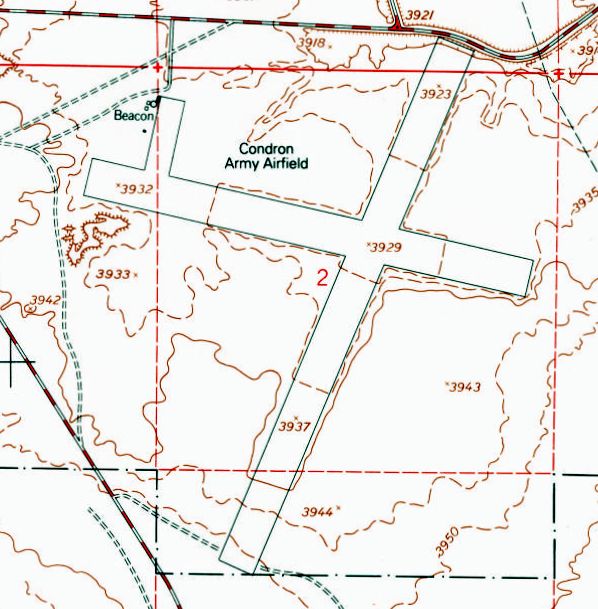
The 1990 USGS topo map showed that Condron Army Airfield had gained a parking ramp with a beacon on the northwest side at some point between 1948-90,
but its control tower was no longer depicted.
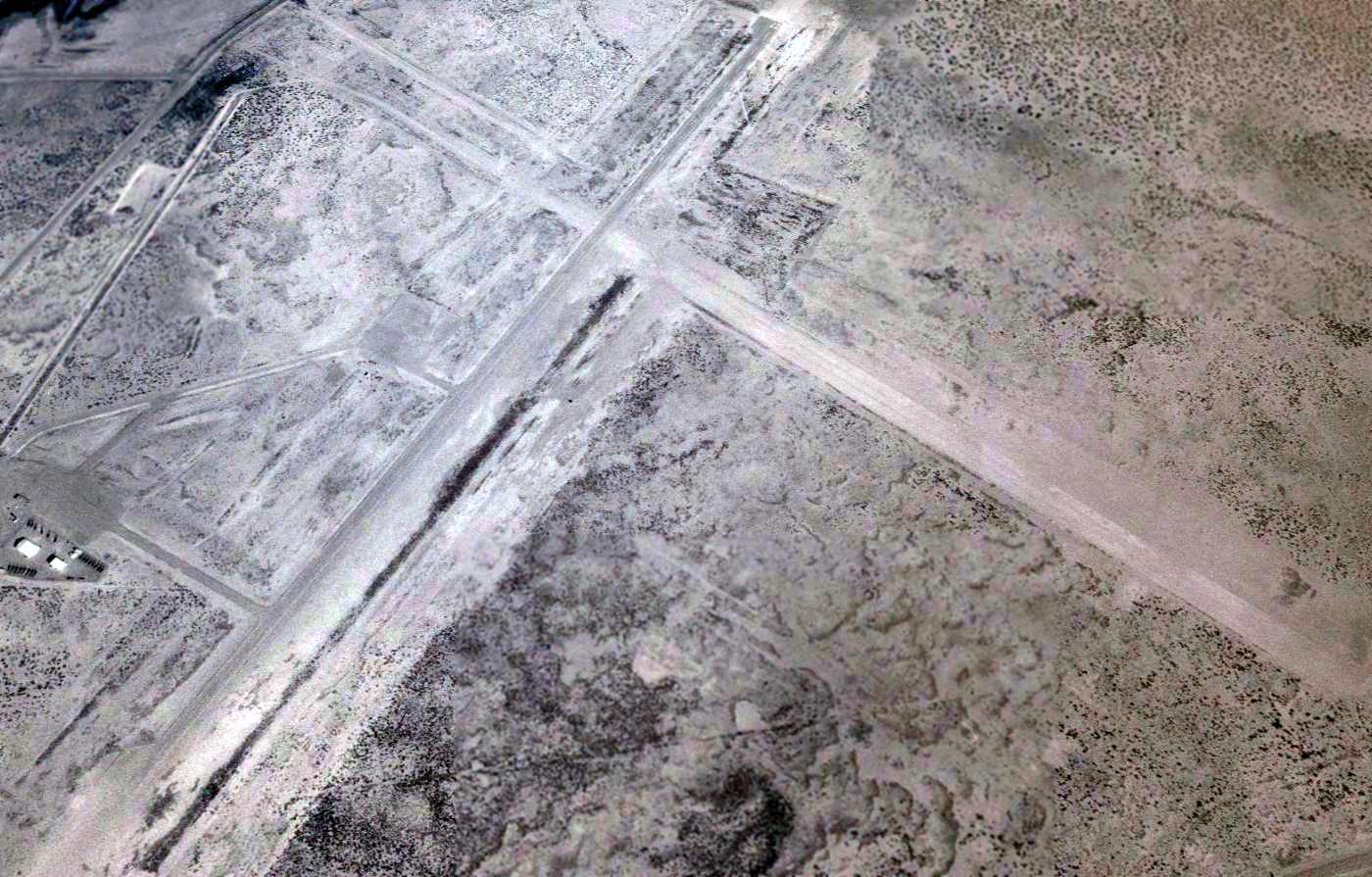
A 1996 aerial view looking east at Condron AAF showed that the southeast/northwest runway had evidently been repaved at some point.
According to a 1998 White Sands Missile Range report, Condron Field supported an average of 4 fixed-wing aircraft or helicopter takeoffs/landings / day
with up to 40 flight missions / day during major military training exercises.
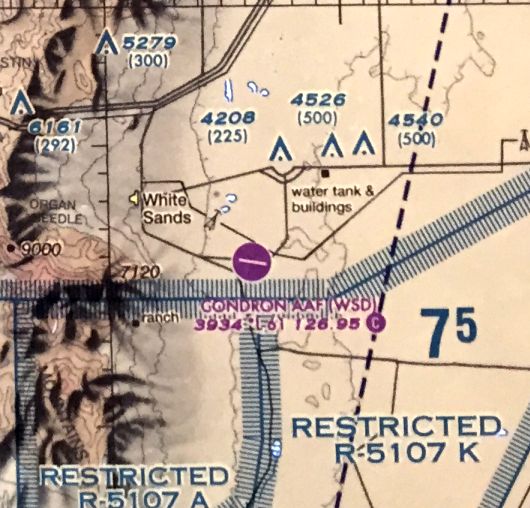
The 2009 Albuquerque Sectional Chart depicted Condron AAF as having a single paved 6,100' northwest/southeast runway.

A 2013 aerial view looking east at Condron AAF showed that a few small buildings (hangars?) had been added at some point between 1996-2013 on the northwest side, presumably to support drone operations.
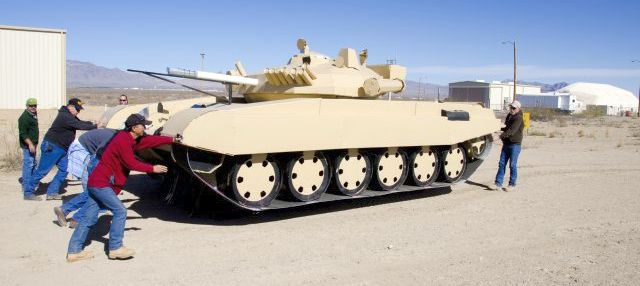

Condron AAF was evidently closed at some point between 2009-2015,
as the 2015 Sectional Chart depicted Condron AAF as having a single paved northwest/southeast runway, but to be closed.
As of 2015, Condron AAF's FAA Airport/Facility Directory data described it as having a 6,175' asphalt Runway 9/27,
but listed the field's status as “Closed Permanently”.
Although this airfield is listed as “closed permanently” (to manned aircraft operations), other indications point to it still being used for drone operations.
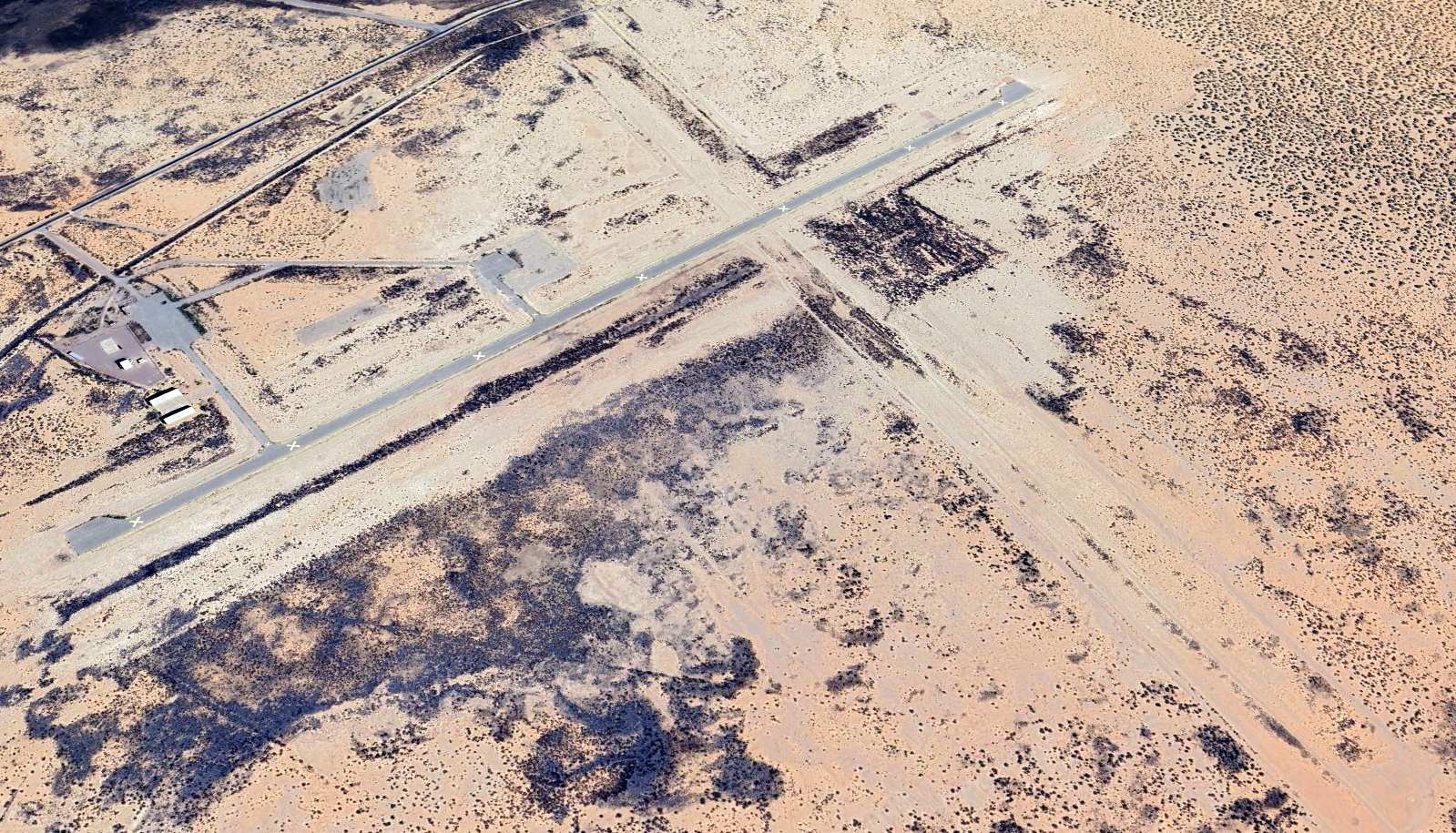
A 2023 aerial view looking northeast showed Condron AAF's former east/west runway to be painted with multiple closed-runway “X” symbols.
Condron AAF is located on the east side of Route 213, 5 miles southeast of White Sands, NM.
Thanks to Mike Marson for pointing out this airfield.
____________________________________________________
32.792, -105.822 (Northeast of El Paso, TX)
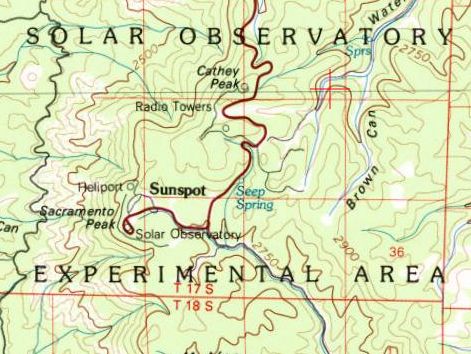
The Sunspot “Heliport”, as depicted on the 1979 USGS topo map.
Photo of the heliport while in use has not been located.
James Carfagno reported, “Near the National Solar Observatory at Sunspot, NM, there is a clear area that I’m told is an old helicopter landing strip.
According to someone who has worked at the observatory for many years, the landing strip is a relic from when the Air Force constructed the observatory in the 1950s.
However no runway or heliport was depicted at Sunspot on USGS topo maps from 1950-72,
nor on the 1955/65 Roswell Sectional Charts.
A 1973 aerial photo depicted a northeast/southwest unpaved clearing at the location of the Sunspot Heliport.
The earliest depiction which has been located of Sunspot Heliport was on the 1979 USGS topo map.

The 1981 USGS topo map depicted the Sunspot “Heliport” as an unpaved northeast/southwest 1,700' runway.

The earliest photo which has been located of the Sunspot Heliport was a 1996 USGS aerial view looking southwest, showing a rough clearing.
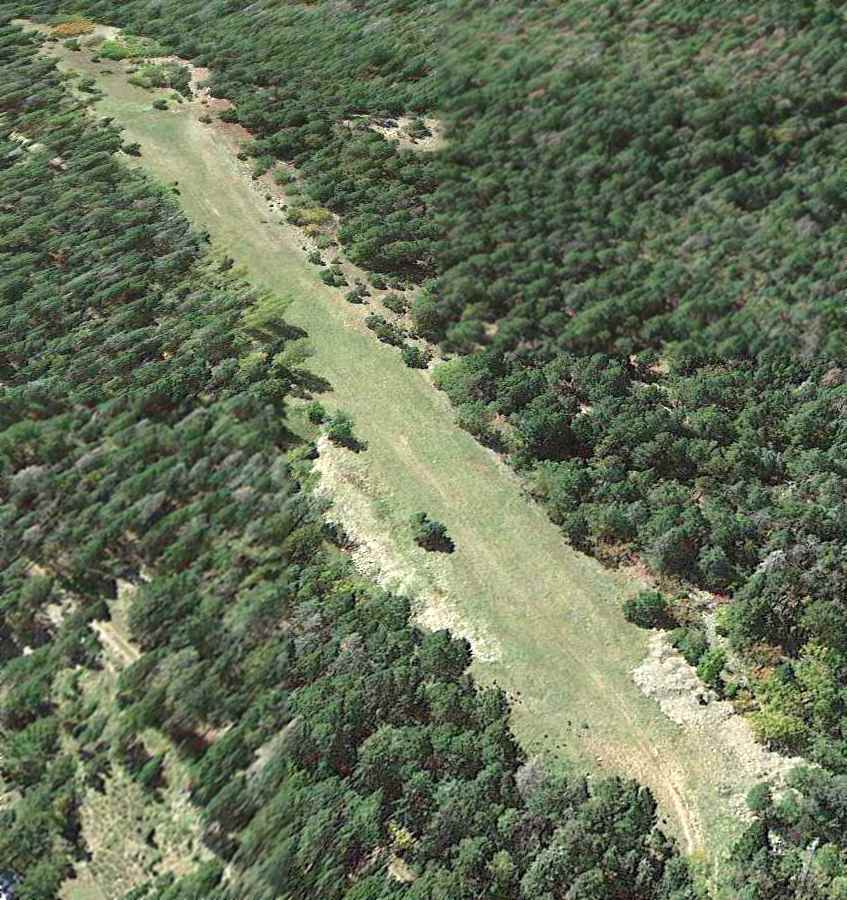
A 2013 aerial view looking southwest shows the Sunspot Heliport remains clear.
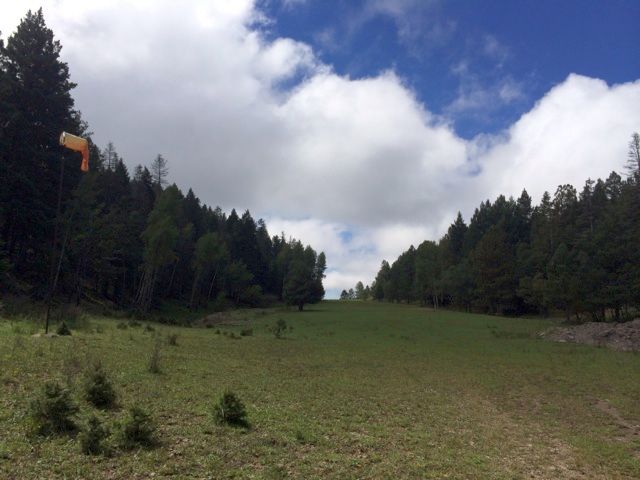
A 2014 photo by James Carfagno of the windsock & runway of the Sunspot Heliport.
James reported, “The only concrete evidence of the site’s aviation past is a faded wind sock, although there are also some piles of asphalt left over.
The windsock doesn’t look that old, so I doubt it’s a leftover from the Air Force days.”
As of 2014 the observatory at Sunspot continues in operation as the National Solar Observatory,
but there is no heliport registered with the FAA at Sunspot.
Thanks to James Carfagno for pointing out this heliport.
______________________________________________________
Tularosa Airport, Tularosa, NM
33.105, -106.03 (North of El Paso, TX)

“Tularosa Airstrip”, as depicted on the 1948 USGS topo map.
This small general aviation airport was evidently established at some point between 1945-48,
as it was not yet listed among active airfields in the 1945 AAF Airfield Directory (courtesy of Scott Murdock).
The earliest depiction which has been located of Tularosa Airport was on the 1948 USGS topo map,
which depicted “Tularosa Airstrip” as having 3 runways.
Ted Harrington recalled, “My Dad & I used to do touch & go's on a dirt strip just north of Tularosa in 1954-56.
There were no buildings! The property along the southern east/west leg of the field was put up for sale for hangars
and a few lots were sold but no construction ever took place.”
However the Tularosa Airport was not depicted at all on the 1950/56/1965 Roswell Sectional Charts.
Larry Cunningham recalled, “North of Tularosa about 2 miles, there was a dirt strip in the desert.
I once saw an Ercoupe parked there in the early 1960s.”
Michael Louis recalled, “I did learn there was a private strip located on the north edge of Tularosa hosting a Piper Cub
but I think that was just private property, probably the Champion/Hobson outfit.”
The 1967 USGS topo map still depicted “Tularosa Airstrip” as having 3 runways.
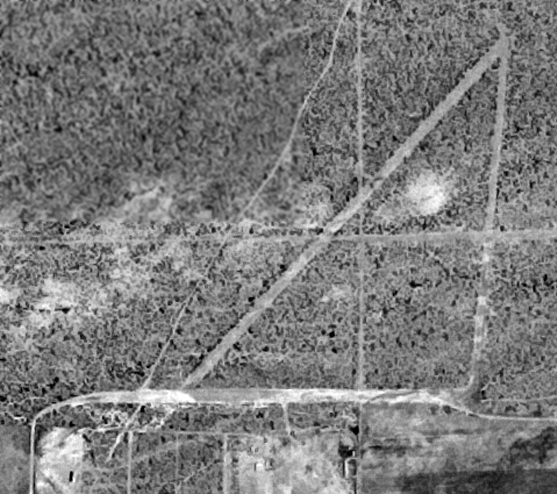
The earliest photo which has been located of Tularosa Airport was an 8/11/73 USGS aerial view.
It depicted Tularosa as having 3 unpaved runways, but the field appeared to be abandoned.
The 1982 USGS topo map no longer depicted the Tularosa Airport.
A 1996 USGS aerial photo showed that the southeastern portion of the runways had been cleared,
but the majority of the length of the runways remained intact.

A 10/5/13 aerial view still showed the recognizable outline of most of the 3 runways at Tularosa.
The site of Tularosa Airport is located east of the intersection of Old Champion Farm Road & Coyote Canyon Road.
______________________________________________________
Alamogordo Airport (original) / Alamogordo Field, Alamogordo, NM
32.93, -105.965 (Northeast of El Paso, TX)
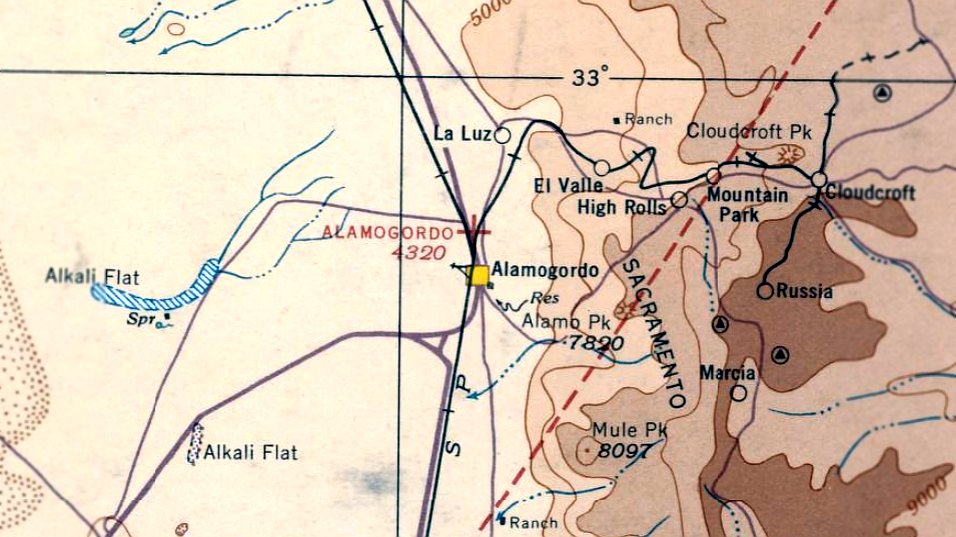
The original Alamogordo Airport, as depicted on the October 1935 Roswell Sectional Chart.
The original airport for the town of Alamogordo was located on the north side of town,
wedged into a narrow “V” in between 2 railroad lines.
The date of establishment of the Alamogordo Airport has not been determined.
The earliest depiction which has been located of the Alamogordo Airport was on the October 1935 Roswell Sectional Chart.
It depicted Alamogordo as an auxiliary airfield.
Mike Louis recalled, “For many years the very north end of Alamogordo was marked by the New Mexico School for the Blind,
at the corner of the highway & a canal easement.
On the north side of that easement & for another 100 yards or so would be the location of that strip.
I arrived in the area about 1936 & occasionally there would be an airplane parked when we came to town to shop.
The airport was situated on the east side of US Highways 54/70.
I remember an old railroad bed that came in on the south side & worked northward to the town of La Luz.”
Mike continued, “My first airplane ride occurred here, probably in 1939.
I weighed 85 pounds & paid 85 cents in new 1938 Jefferson nickles.
The flight was in a Stinson Reliant, or maybe it was an SR-7. I rode in the right seat & 2 others occupied the rear.
The flight lasted long enough to circle the town of Alamogordo & return to the strip with a short pause to do a wingover before landing.
I think [the runway] ran east/west.
I have always believed that the strip was the private doing of George 'Chakie' Breece.
Breece was a well established lumber man in New Mexico.
He had a mill in Alamogordo (Breece Lumber Company) and he had an airplane he used to travel from one business to another.
I believe he put the strip in for himself but it was basically owned by Alamogordo.
In those days that land was all public domain & a section of it could be homesteaded for a $10 filing fee & survival on it for 10 years.
Not many takers then.”
Mike continued, “In the late 1930s Chakie was in town & one morning went out & began buzzing the city of Alamogordo, scaring the wits out of everyone.
Finally he quit & landed. Along comes Bill Speight.
Bill was the State Police officer assigned to the Alamogordo district & he picked up Chakie & lodged him in the poky for several hours.
When considered sufficiently sober Bill opened the cell & took Chakie back to his car.
That was the end of the matter except for the amount of conversation in town that followed the event.”
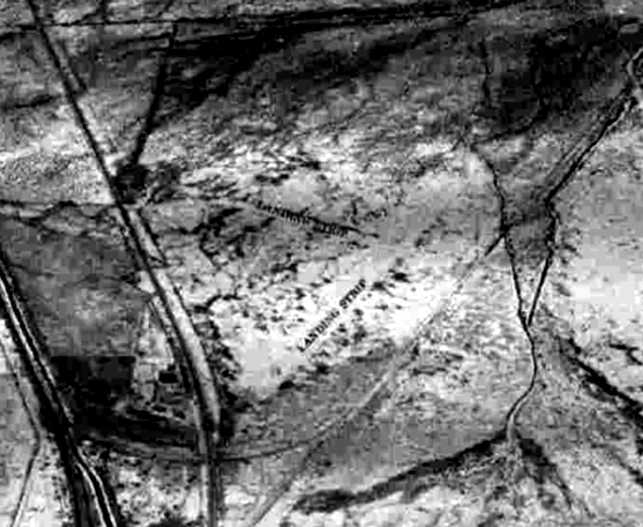
The earliest photo which has been located of the Alamogordo Airport
was a 10/5/43 aerial view looking north from the 1945 AAF Airfield Directory (courtesy of Scott Murdock).
It depicted “Alamogordo Field” as having 2 unpaved landing strips.
The 1945 AAF Airfield Directory (courtesy of Scott Murdock) described “Alamogordo Field”
as a 110 acre triangular property having 3 adobe runways, with the longest being a 2,850' NNE/SSW strip.
The field was said to not have any hangars or airline service,
to be owned by the City of Alomogordo, and operated by private interests.
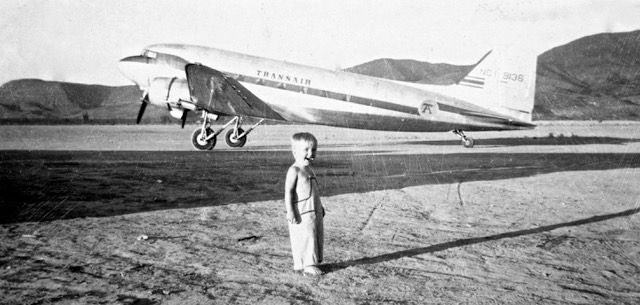
A 1947 photo of Mel Brashears in front of a Transair Airlines Douglas DC-3 at the original Alamogordo Airport.
Compare this photo with the 2020 photo (several paragraphs below), taken at the same spot & in the same direction.
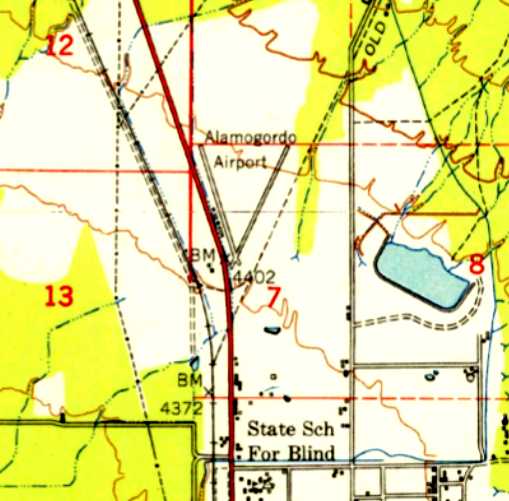
The earliest topo map depiction which has been located of the Alamogordo Airport was on the 1950 USGS topo map.
It depicted the Alamogordo Airport as having 2 runways with a row of small buildings along the west side.
According to Mike Louis, the 1951 World Aeronautical Chart depicted the original Alamogordo Airport as having a 2,900' runway.
Ted Harrington recalled, “My Dad (Charlie Harrington) was considered the Manager of the Alamogordo Airfield in 1952-59.
Charlie was an A&E Certified Mechanic & overhauled many of the local airplanes.
He also maintained the dirt runways (I got to ride in the grader) great fun when you are 10/11 years old.
In the airport Office there were many framed photos of old strange airplanes.
I saved them and still have them as well as the desk that was in the office.
When it came time to vacate the old airport & move out to the new airport southwest of town,
Dad dumped most of the spare parts & general junk down the 'Airport Outhouse' holes (there was a dual outhouse for men & women).
So someday just maybe when they are digging up utilities out there about where 'Peppers' front parking lot is
they will find some Continental & Franklin 'jugs' & pistons & all kinds of old instruments & general airplane junk.”
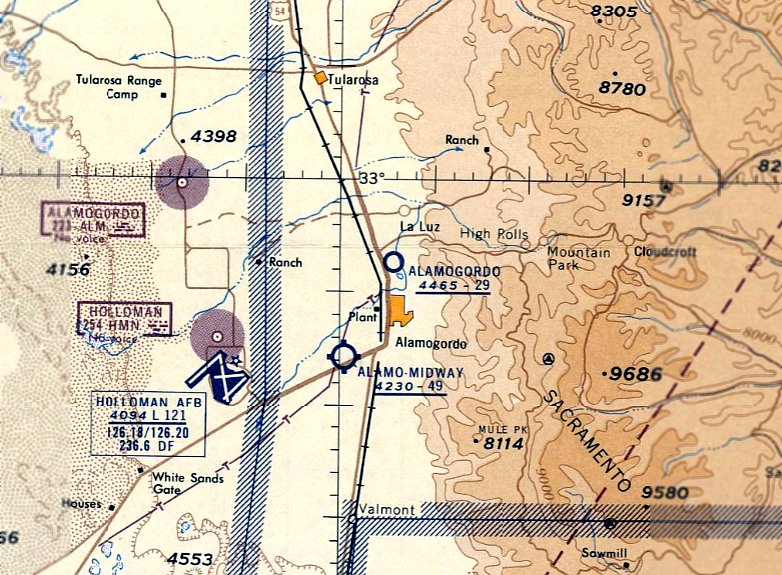
The last aeronautical chart depiction which has been located of the original Alamogordo Airport was on the June 1959 Roswell Sectional Chart.
It depicted Alamogordo Airport as having a 2,900' unpaved runway.
The original Alamogordo Airport was evidently closed at some point in 1959,
as it was no longer depicted on the November 1959 Roswell Sectional Chart.
It had evidently been replaced by 2 larger airports on the southwest side of town.

A 2/1/76 aerial photo did not show any recognizable trace remaining of the original Alamogordo Airport.
Mike Louis recalled, “The last time I was in he area was 2004
and I tried to remember just where the strip was but too many years have gone by & the area has changed with business and buildings all over.”

A 4/3/10 aerial view did not show any recognizable trace remaining of the original Alamogordo Airport.
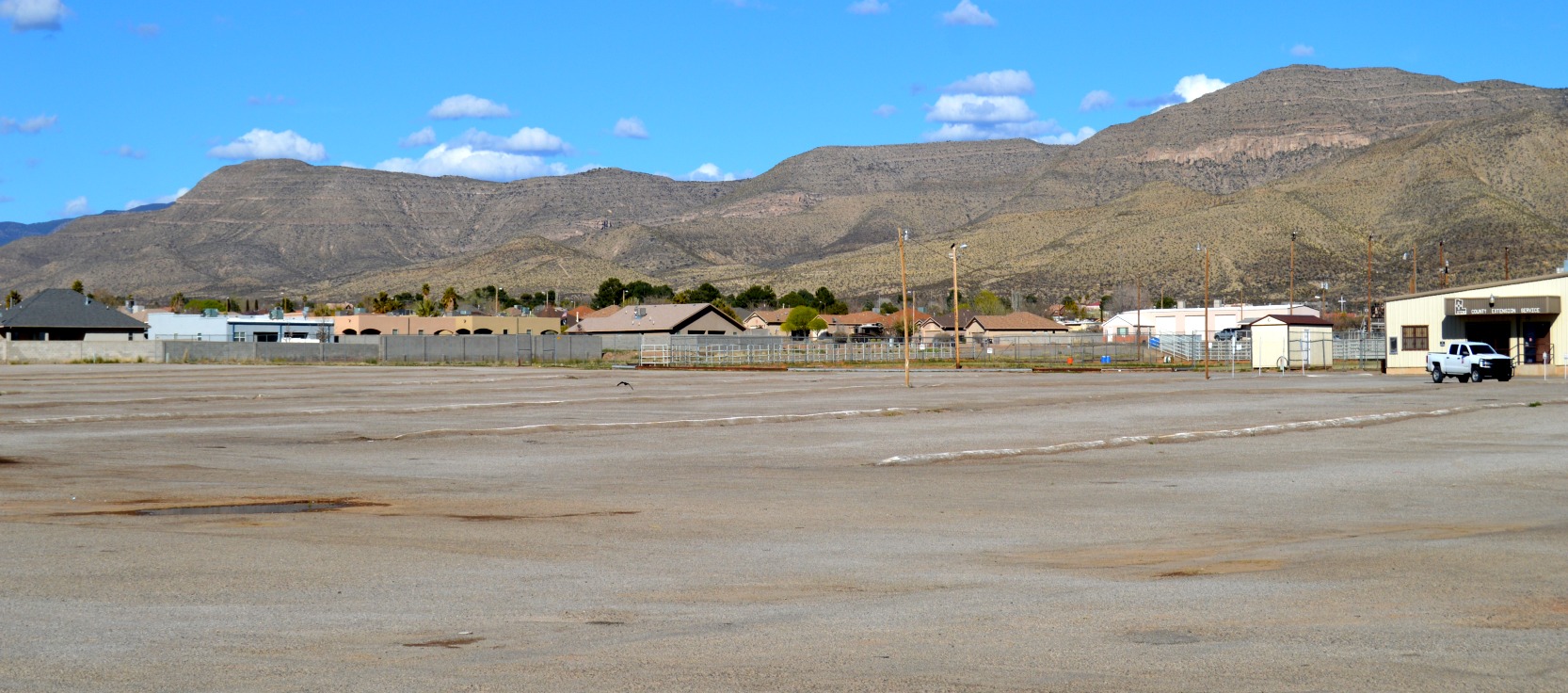
A 3/7/20 photo by Fred DeGuio of the site of the original Alamogordo Airport, matching the same perspective as the 1947 photo several paragraphs above.
Fred observed, “The mountains do appear to be a match. My photo was taken in a large parking lot for the Otero County Fairgrounds
on the northeast corner of White Sands Boulevard & Fairgrounds Road.”
The site of the original Alamogordo Airport is located south of the intersection of Routes 70 & 82.
______________________________________________________
Northrup Strip / White Sands Space Harbor, White Sands, NM
32.94, -106.42 (North of El Paso, TX)

Northrup Strip, as depicted on the June 1965 Roswell Sectional Chart.
The airfield known as Northrup Strip is located in a salt/gypsum area called Alkali Flats.
The date of establishment of Northrop Strip has not been determined.
It was not yet listed among active airfields in the 1945 AAF Airfield Directory (courtesy of Scott Murdock).
It was labeled “White Sands Proving Ground” on the 1947 USGS topo map, but no airfield was depicted.
This area was first used as an airfield in the late 1940s,
when Northrop Aviation Corporation used the natural landing area for target drone projects.
The strip was unofficially called "Northrop Strip" through association with the contractor.
The Northrop Strip area became part of the Army's White Sands Missile Range in 1952.
An early press release contained a typographical error, misspelling Northrop as "Northrup".
The error was reproduced in subsequent releases,
and later signs, route markers and official Army maps carried the name "Northrup Strip", making it quasi-official.
Northrup Strip was not yet depicted on the February 1961 Roswell Sectional Chart.
The earliest depiction of Northrup Strip which has been located was on the June 1965 Roswell Sectional Chart.
Notably, it depicted the field as having a 32,000' unpaved runway.
Northrup Strip's original (primary) runway is oriented north-northeast/south-southwest.
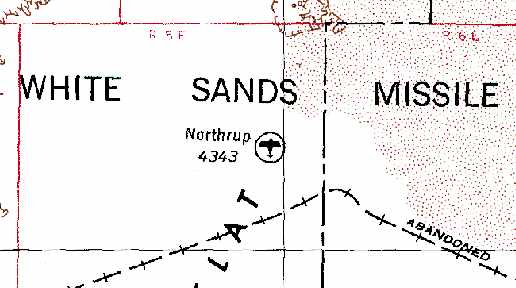
Northrup Strip, as depicted on the 1971 USGS topo map (courtesy of David Brooks).
In the early 1970s, NASA began looking at possible launch & landing sites for the forthcoming Space Shuttle Program.
In the early stages, Northrup Strip was considered a candidate for both categories.
NASA officials finally decided upon Kennedy Space Center as the launch site,
and Edwards AFB as the early mission landing site (routine landings would eventually be made at Kennedy).
In 1976, NASA selected Northrup Strip as the site for shuttle pilot training.
A second runway was added, oriented east-northeast/west-southwest.
The primary (north-northeast/south-southwest) runway is configured to simulate the runway at Kennedy Space Center,
while the second (east-northeast/west-southwest) runway simulates the lakebed runway at Edwards AFB.
Northrup Strip has served as the initial training point for shuttle astronauts since October 1978,
with the first landing practice taking place on 8/13/78.
Since then practice landing missions at the strip have averaged about 9 sorties/week to include both day & nighttime missions.
A Grumman Gulfstream II jet aircraft, modified to react similarly to the shuttle, is used for astronaut training.
It was this training assignment which paved the way to White Sands being named & outfitted as an orbiter landing site.
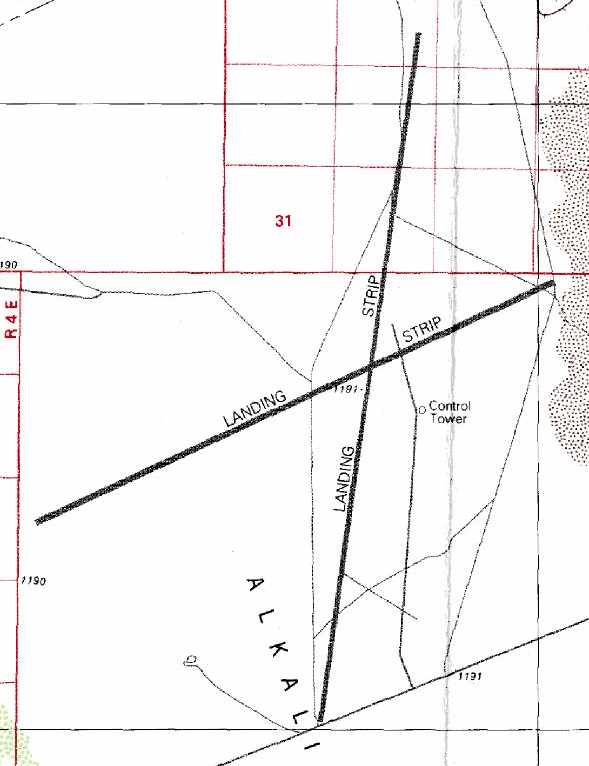
Two runways of White Sands Space Harbor were depicted on the 1978 USGS topo map (courtesy of David Brooks),
but they were only labeled as "Landing Strip".
A control tower was depicted to the southeast of the runway intersection.
Northrup Strip was not given a Space Shuttle landing site role until 1979,
when both lakebed runways were lengthened to 35,000' total length,
which includes 15,000' usable runway with 10,000' extensions on either end.
These hard packed gypsum strips provided what the Space Shuttle needed in the early landings - a long, forgiving runway.
Northrup Strip is virtually unobstructed, can be seen from space,
and is blessed with excellent weather 90% of the time.
The first space flight of the Space Shuttle, mission STS-1 using the orbiter Columbia, was launched from Kennedy Space Center on 4/12/81.
Northrup Strip was designated the primary Abort-Once-Around (AOA) & contingency End-of-Mission (EOM) landing site.
Despite several weeks of exhausting work by WSMR personnel making Northrup Strip & the range ready,
the Columbia ended its 3-day flight at Edwards AFB as planned.
After several delays, the Columbia's second flight launched from Kennedy on 11/12/81.
Sands Missile Range had anticipated a lesser chance of a landing,
having been designated contingency AOA & contingency EOM landing site.
However, Columbia carried out a normal landing at Edwards AFB on 11/14/81.
Five days prior to the scheduled launch of the third shuttle space flight, mission STS-3,
NASA announced Northrup Strip as the primary EOM landing site.
WSMR & Northrup Strip personnel had spent many weeks in preparation,
but the End Of Mission Landing Site announcement still came as a surprise.
Soggy runways at Edwards had forced NASA officials to make the EOM decision for Northrup
where, aside from some predictable March winds, the weather was spring-like & balmy.
The Columbia launched on schedule on 3/22/82, and drifted through an almost uneventful planned seven-day flight.
On the planned landing day, March 29, White Sands Missile Range
experienced one of the worst wind & sand storms in more than 25 years.
A public viewing site had been set up about 7 miles northwest of the landing strip,
where an estimated 7,000 spectators had accumulated on Monday when the storm occurred.
The STS-3 mission was extended one day, and then landed on White Sands' Runway 17 on 3/30/82.
Jack Lousma & Gordon Fullerton flew the landing, which involved a rollout of 13,732' over 83 seconds.

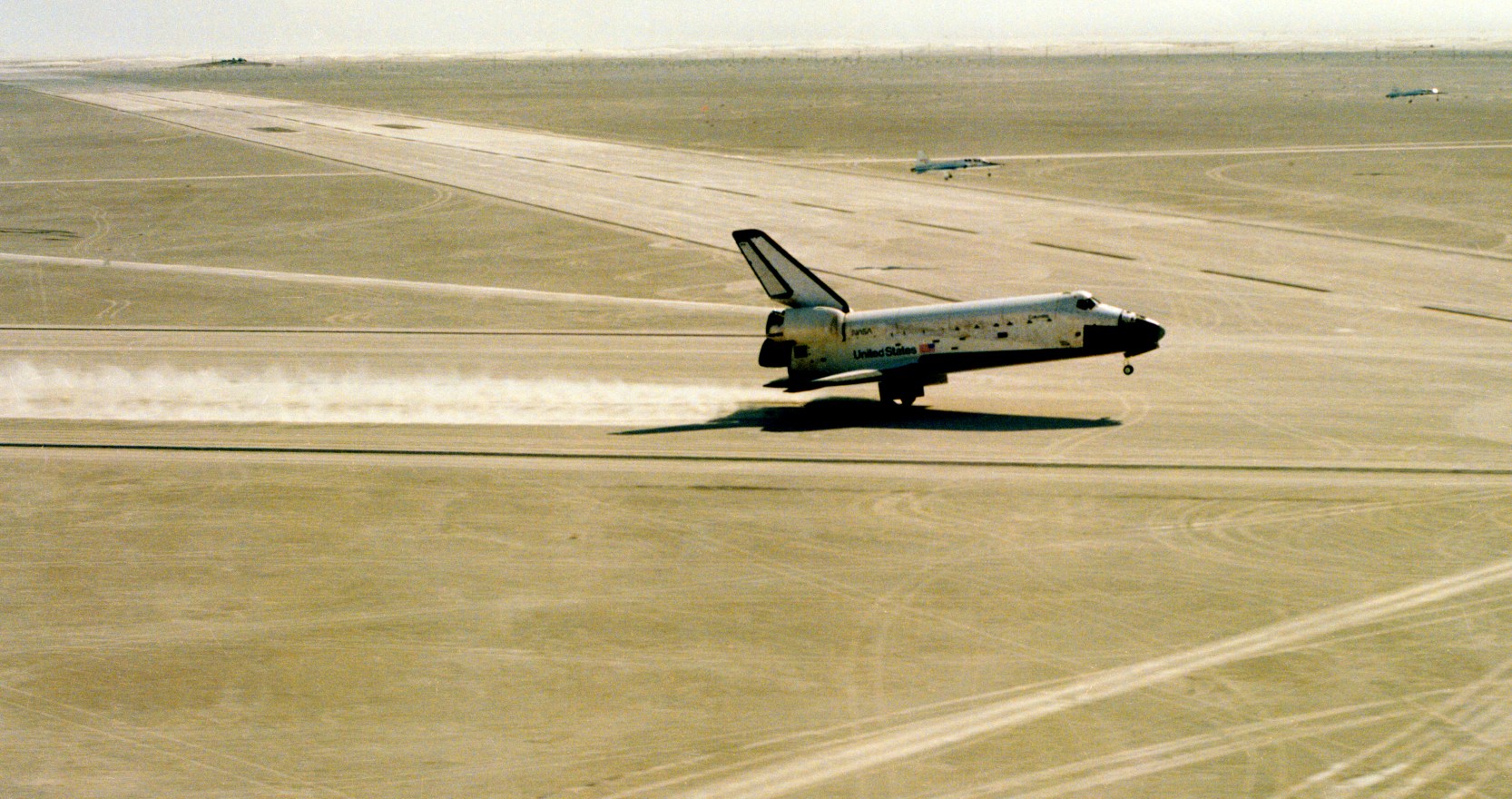
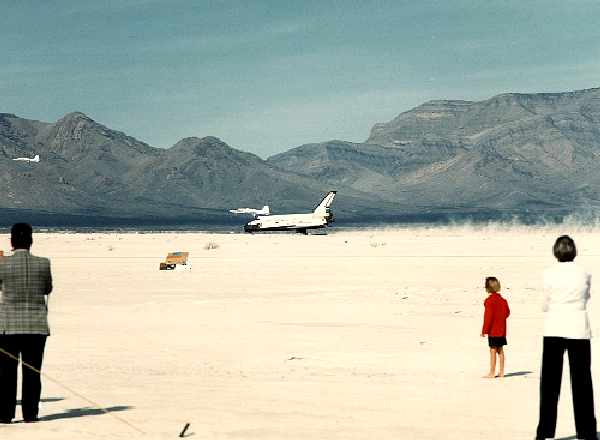
A 3/30/82 NASA photo of the landing of Space Shuttle mission STS-3 at White Sands, along with T-38 chase aircraft.
Some 4,000 spectators were present for Columbia's landing.
Astronauts Lousma & Fullerton were applauded at the press area where they were greeted by New Mexico's Governor Bruce King,
WSMR's Commander Major General Alan A. Nord and New Mexico U. S. Senator Harrison "Jack" Schmitt.
However, some brake damage upon landing & a subsequent dust storm caused extensive contamination of the orbiter.
Another 90,000 spectators later saw the shuttle at Northrup Strip during its preparation for return to Kennedy Space Center.
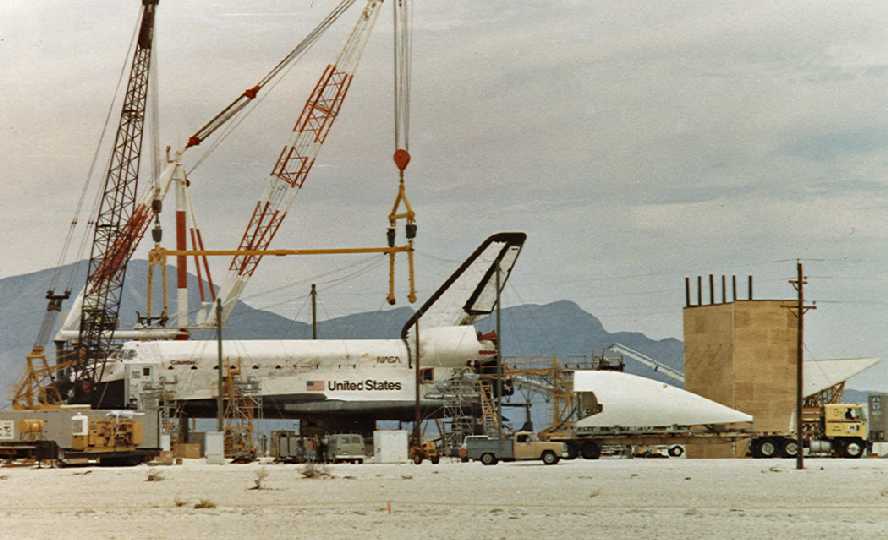
A 4/3/82 photo by Steve Schmidt of the Space Shuttle Columbia being prepared for hoisting by the derrick at White Sands.
Steve recalled, “The day we went to view the Shuttle, we were advised to arrive at the Tularosa gate to 'caravan' in behind a military escort.
The trip in from the gate took a very long time as we weren't allowed to exceed a certain speed, and it was something like 25 miles to the view area.
Once we were at the viewing area, you were about an 1/8 of a mile from the Shuttle itself.
While we were there we saw the arrival of the rear aerodynamic engine covering [pictured at right of the Shuttle].”
A factor weighing heavily in NASA's decision for a landing at other than Edwards AFB
was the placement of a huge crane called the Stiffleg Derrick at Northrup Strip.
This derrick, assisted by a large conventional mobile crane,
hoists the shuttle aboard NASA's modified 747 Shuttle Carrier Aircraft for transport back to Kennedy.
For the STS-3 landing at Northrup, NASA moved some 350 personnel
and 2 trains of 23 & 21 cars each from Edwards to Northrup Strip.
Preparations to send the Columbia back to Kennedy were accomplished in only 7 days.

A 1982 NASA photo of the Space Shuttle being mounted back on its 747 carrier aircraft following its landing at White Sands.
On 4/6/82 the Columbia, firmly attached to the back of the 747, lifted off from Northrup Strip on its return to Kennedy Space Center.
Shortly after the Columbia landed at White Sands Missile Range,
Congress passed a bill introduced by Senator Schmitt & signed by President Ronald Reagan on 3/11/82,
renaming Northrup Strip as "White Sands Space Harbor."
On 9/15/82, in accordance with Army Regulation 1-33, Major General Nord, designated the area where astronauts Lousma & Fullerton
rejoined their families after the landing of STS-3 as "Columbia Site".
This site was marked by a permanent survey marker at the south end of White Sands Space Harbor
near the location where NASA officials had their temporary operations facility.
Most subsequent Shuttle flights have landed on the shorter, concrete runways at Kennedy & Edwards.
During the lapse in Shuttle flights following Challenger, the Space Harbor runways were laser-leveled, widened to 900',
and a new concrete mating/deservice area & towway were built
to move any future operations out of areas with blowing gypsum sand.
The original crane was removed, and plans were to use 2 rented mobile cranes from mating operations in the event of a landing.
Also, a full set of convoy equipment specially designed to safe the Shuttle after landing was kept at the Space Harbor.
The runways included all landing aids necessary for a Shuttle landing,
including the Microwave Scan Beam Landing System (MSBLS).
Crash & rescue emergency personnel were provided for practice sessions & for any landings by nearby Holloman AFB.
The runways at the Space Harbor were completely lit with Precision Approach Path Indicator (PAPI) lights,
distance-to-go lights, strobe lights; reflectors, and xenon spotlights that totaled more than 11 billion candlepower.
In 1989, a third, narrower & shorter practice runway was constructed (located to the northwest of the others)
to allow pilots to simulate transatlantic abort (TAL) landings.
The runway was a duplicate in size of the TAL landing site at Ben Guerir, Morocco.
It was also used to simulate landings at 2 other contingency landing sties: Moron, Spain & Banjul, The Gambia.

A 1996 USGS aerial view (courtesy of David Brooks) showed White Sand's 2 massive unpaved runways.
There did not appear to be any hangars or other buildings intended to support the basing of aircraft at White Sands.
The only building at the site consisted of a control tower, southeast of the runway intersection.
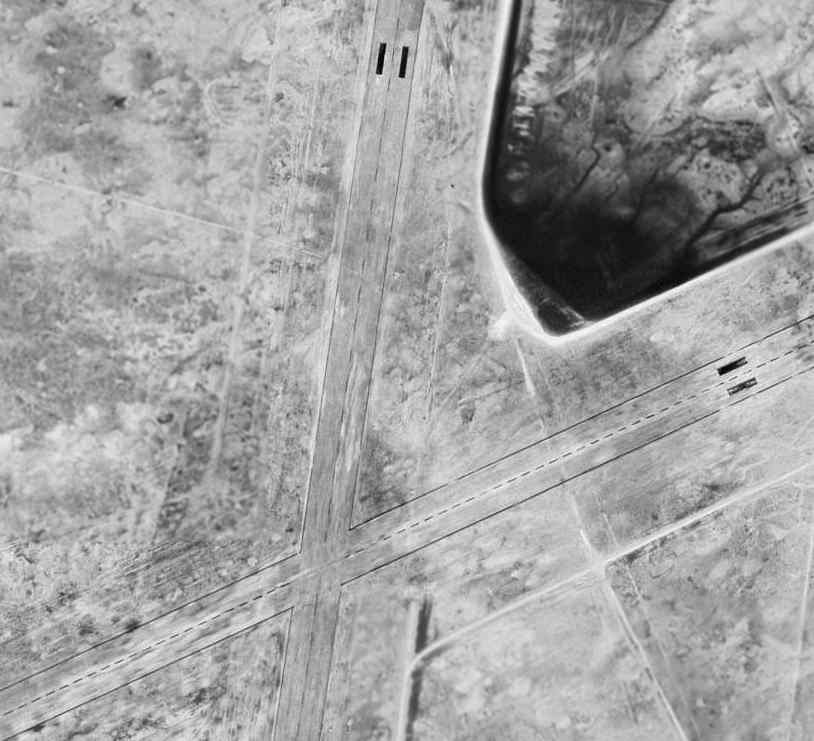
A closeup of the runway intersection from the 1996 USGS aerial photo (courtesy of David Brooks).
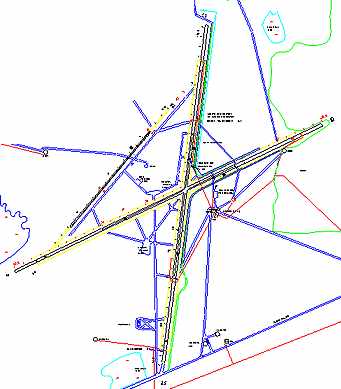
An undated NASA diagram of the runway layout of White Sands Space Harbor.
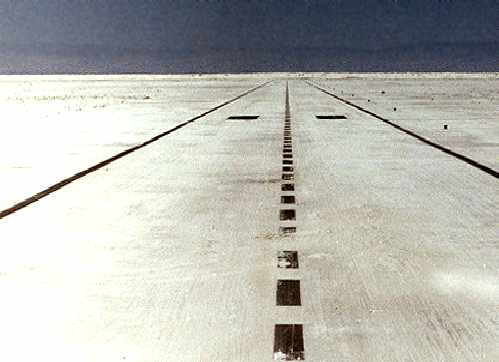
An undated NASA photo of White Sands' Runway 17.
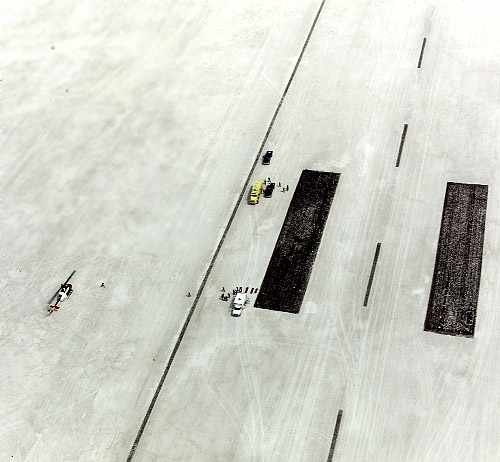
An undated NASA photo of a UH-1 helicopter & other emergency vehicles on a White Sands runway.
As of 2004, WSSH was one of 3 designated "Abort Once Around" landing facilities.
It was the primary facility for high inclination launches (greater than 51.6 degrees)
and secondary for International Space Station missions (51.6 degrees).
All 3 runways were groomed continually for training missions,
and the north/south & east/west runways were laser leveled to a tolerance of ± 1 in / 1,000' to maintain readiness for shuttle landing.
The long runways were certified yearly to support the weight of the shuttle aircraft by using a large specially designed load cart.
NASA's White Sands Test Facility (WSTF) operated the White Sands Space Harbor (WSSH),
the primary training area for space shuttle pilots flying practice approaches & landings in the shuttle-training aircraft & T-38 chase aircraft.
The STA was a Gulfstream II aircraft modified to mimic the flight characteristics & instrumentation on the shuttle
and provided a realistic simulation of the shuttle's landing from high altitudes to touchdown.
Ironically, these practice approaches by the STA aircraft did not terminate in actual landings at the White Sands airfield,
and the STA aircraft were based at NASA facilities at the El Paso International Airport.
Although STS-3 was the only shuttle mission to land at White Sands, the missile range continued to support on-going shuttle missions.
This support included preparation for a possible AOA landing on launch day.
During any mission, the range was prepared to accept a landing of the shuttle on a contingency basis with as little as 3-hour notification.
Preparations during these times included monitoring the shuttle during flight via tracking & telemetry systems.
In addition, all systems at the harbor were turned on & brought up to full operation.
Throughout the entire shuttle mission, the missile range kept NASA abreast of the harbor's weather conditions in case it was needed for a landing site.
Ironically, in spite of its continued use by NASA, the massive runways at Northrup Strip were not depicted on aeronautical charts
(not on the Albuquerque Sectional Chart from 1968-2004, according to David Brooks),
and were not listed in the FAA's Airport/Facility Directory (not even as a restricted government airfield).
How strange was it that an airfield with some of the world's longest runways was not even depicted at all on aeronautical charts?

A circa 2006 aerial view looking north along White Sands' Runway 35.
Lance Grace (former USAF Test Pilot w/ 6 years flying out of HMN on WSMR) reported in 2013,
“White Sands Space Harbor is now closed down. That happened about 2 years ago [2011] when maintenance on the runways was no longer required.
A few things that I was involved with out on that runway: launch & recovery of QF-86 full-scale drones,
emergency landing of a QF-100, launch & recovery of a sensor hanging about a mile behind an A-3,
the emergency landing of a KC-135 with an extremely significant landing gear problem.”
The White Sands Space Harbor is located 15 miles northwest of Route 70.
Thanks to David Brooks for pointing out this airfield.
See also:
http://www.wstf.nasa.gov/WSSH/Default.htm
http://www-pao.ksc.nasa.gov/kscpao/chron/sts-3.htm
______________________________________________________
White Sands Airport / Alamo Midway Airport, Alamogordo, NM
32.87, -105.993 (Northeast of El Paso, TX)
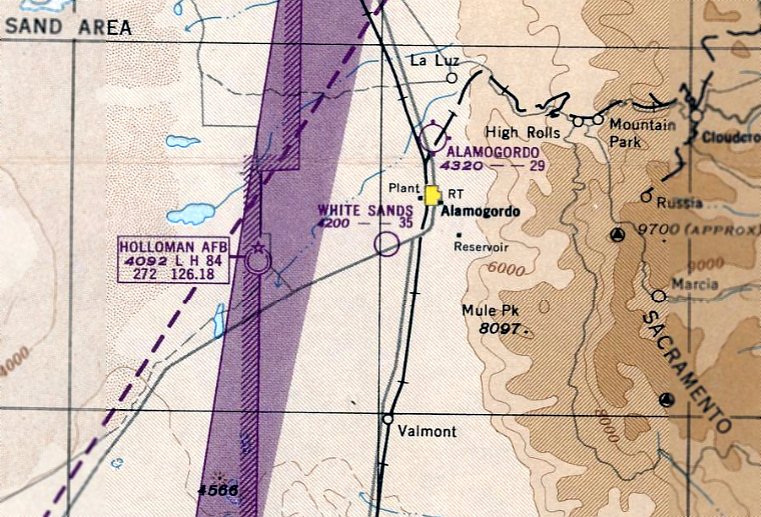
White Sands Airport, as depicted on the August 1949 Roswell Sectional Chart.
According to his nephew John Bedke, “In 1946, Lt. Col. Lawrenz “Larry” Dyvad
was assigned to Holloman AFB New Mexico working on high altitude projects.
In 1946 Larry & Deloris purchased the land for Alamo Midway Airport, Alamogordo.
In 1946 they built a gas station & a home on the land.
While Larry continued his career in the AAF, Deloris operated the gas station.
They established the Alamo Midway Airport in 1948.”
Alamo Midway / White Sands Airport was not yet depicted on the March 1949 Roswell Sectional Chart.
The earliest depiction which has been located of White Sands Airport was on the August 1949 Roswell Sectional Chart.
It depicted White Sands Airport as having a 3,500' unpaved runway.
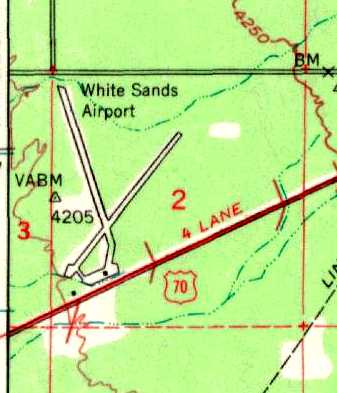
The 1950 USGS topo map depicted White Sands Airport as having 2 runways, with a ramp & 2 small buildings on the south side of the field.

A 1959 photo by John Bedke looking southwest at Alamo Midway Airport's main Runway 3/21,
with aircraft parked on the flightline on the left, and small hangars on the left & right.
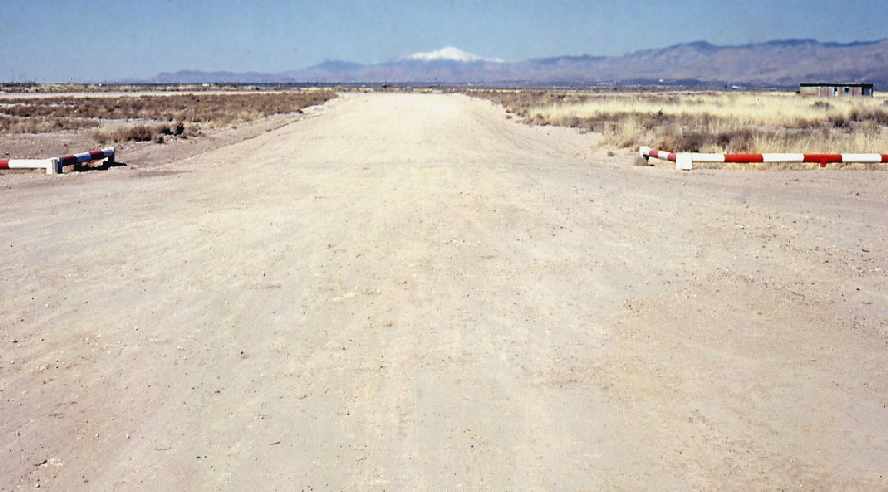
A 1959 photo by John Bedke of Alamo Midway Airport.
According to Lance Grace, the photo was “taken from somewhere near the hangar area & is looking NNE directly at snow covered Sierra Blanca ('Mountain White').
That means that it is looking along the taxiway from the hangar to the intersection of the runways.”

The 1960 Jeppesen Airway Manual (courtesy of Chris Kennedy) depicted Alamo-Midway as having a single 4,925' Runway 2/20
(along with an abandoned northwest/southeast runway), with a ramp on the south end of the field with several buildings.
The field was said to be unattended.
According to John Bedke, “Larry retired from the USAF in 1961, after 24 years active service.
Larry & Deloris then devoted time to the airport, gas station & traveling in their Cessna 120.”
Tom Stanton recalled, "I had a Luscombe 8A tied down at this airport from 1961-1962.
I moved to California in late 1962 but used to stop by to see for several years."
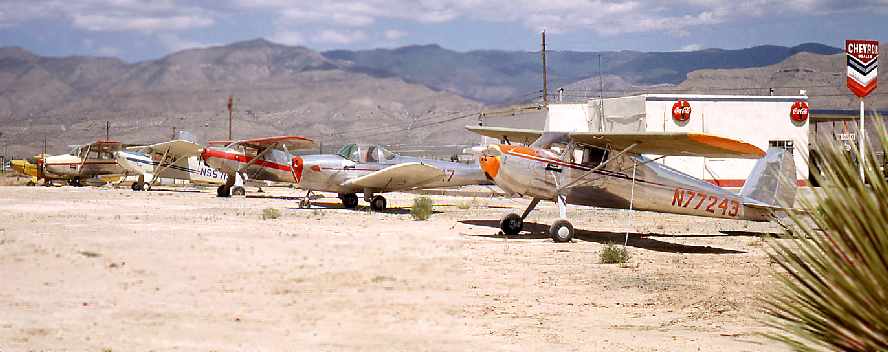
A May 1963 photo of the Alamo Midway Airport flightline with the service station in the background (courtesy of John Bedke).
Airport owner Larry Dyvad's Cessna 120 is the closest airplane.
John observed, “Aircraft parking was on each side of the runway in later years.”
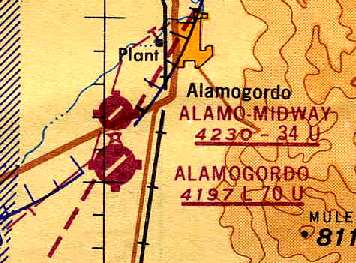
The Aerodromes table on the 1963 Roswell Sectional Chart (courtesy of Chris Kennedy)
described Alamo-Midway Airport as having 2 runways, with the longest being a 3,400' asphalt strip
(along with a remark indicating that the northwest/southeast runway was for emergency use only).
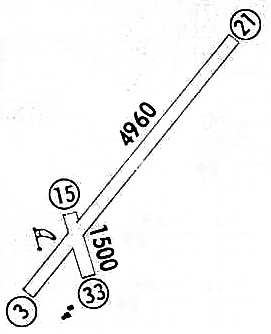
The airfield layout of Alamo-Midway Airport, from a 1967 airport directory (courtesy of Chris Kennedy).
The primary runway at Midway had apparently been lengthened at some point between 1963-67,
as a 1967 airport directory depicted Runway 3/21 as being 4,960' long.
Two small buildings (hangars?) were depicted on the southwest corner of the field.
"Midway" was still depicted as a public-use airfield on the December 1968 Albuquerque Sectional Chart (courtesy of Chris Kennedy).
According to John Bedke, “Larry was killed at age 59 as a passenger in a plane crash near his airport on 2/10/73.
Also killed were USAF Col. Clement D. Billingslea, age 44, and David S. Wilson, age 51, retired USAF.
The aircraft was a brand new 1973 Beechcraft Sierra in white & yellow paint.
Deloris tried to continue the airport business, but it slowly died without Larry.”
John continued, “The runways were never paved, they were graded hard pack dirt.
The airport never had a control tower, but it could be contacted via radio in the Dyvad residence/office.
By 1973 Alamo Midway had several small hangars, aircraft parking
and out-buildings on each side of Runway 3/21 at the southwest end of the airport.”
Tom Stanton recalled, "One year, perhaps early 1970s, I came through & he [airport owner Larry Dyvad] was gone & the airport was gone."
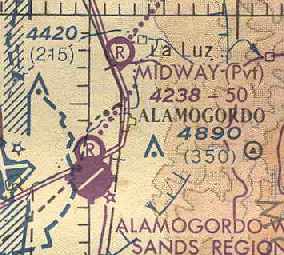
Midway Airport had apparently changed to a private field by 1977,
as that is how it was depicted on the July 1977 World Aeronautical Chart (courtesy of Chris Kennedy).
Midway Airport was still depicted on the 1979 USGS topo map.
According to John Bedke, “The airport does not have a closing date, but the last tenant aircraft was gone by 1982.”
However, by the time of the 1988 USGS topo maps, the former Midway Airport was labeled merely as "Landing Strips",
which most likely indicates that it was indeed closed by that point.
Midway Airport was definitely closed prior to 1993,
as it was no longer included among active airfields in the 1993 Flight Guide (according to Chris Kennedy).
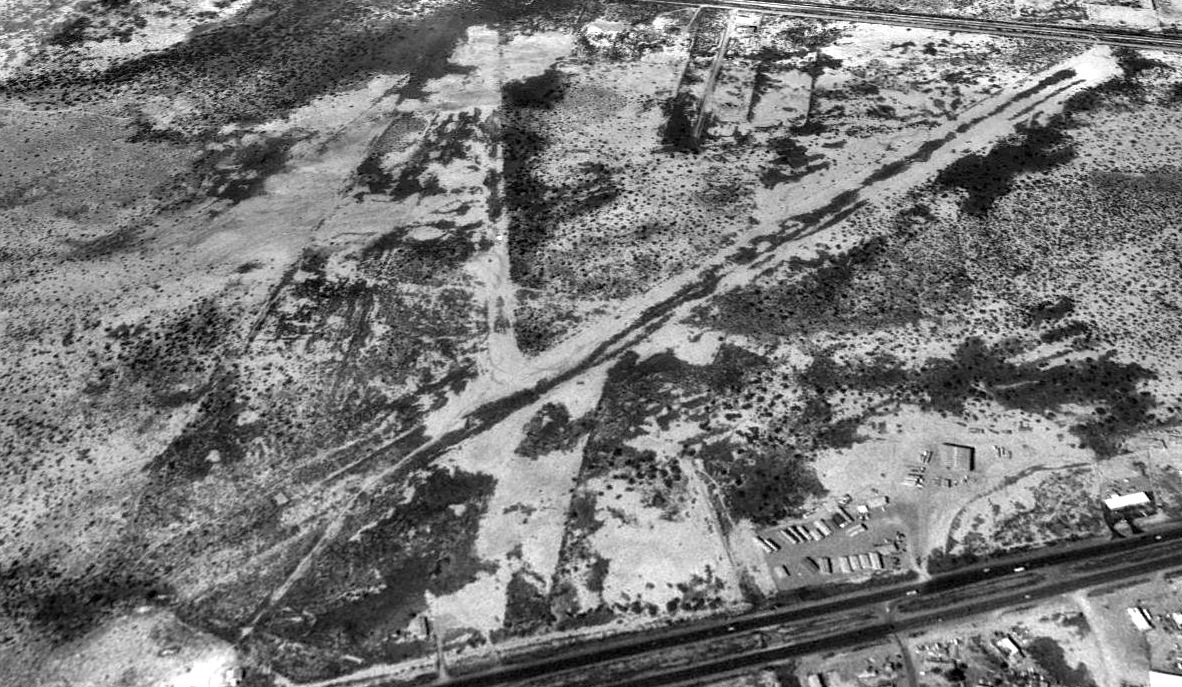
A 1996 USGS aerial view looking northwest showed the remains of both Midway Airport runways were still quite recognizable, although quite deteriorated.
It appeared as if Runway 15/33 had been lengthened at some point after 1967,
as it was quite a bit longer than was depicted in the 1967 airfield directory.
A single former hangar appeared to remain, south of the runway intersection.
According to John Bedke, “She [Deloris Dyvad] was able to continue the gas station business
and lived in her home at the closed airport until she passed away in 2006.”
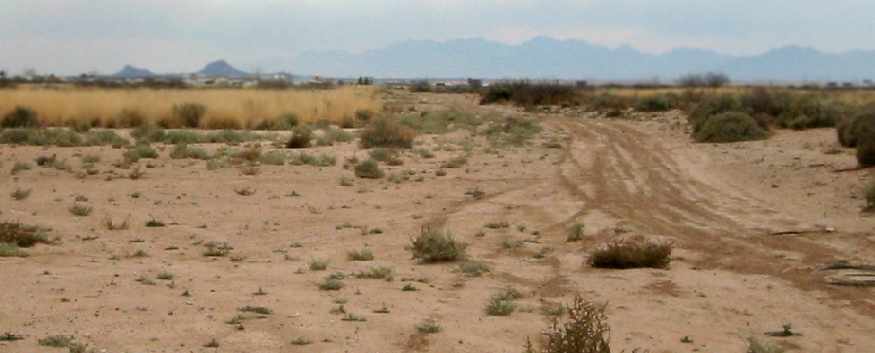
A 2006 photo by Jonathan Westerling, looking south along the remains of the former Midway Airport Runway 21.
According to Jonathan, “The main runway now has an RV park cutting through it.
We found no evidence that the runway was ever paved (as depicted on the 1963 Roswell Sectional).
Instead it appeared as though the main runway was likely oiled sand at the time.”

A 2006 photo by Jonathan Westerling of the front & back of a former hangar which remains standing at the site of Midway Airport.
According to Jonathan, “I'm happy to report that the airport's main hangar still exists.
It's being maintained as the shop for a small construction company.”
John Bedke reported in 2008, “A family member still lives in the airport home.
In 2008 only a trace of the runways remain & only 1 hangar building remains, it is next, to the east, of the service station building.
A mobile home park now cuts into Runway 3/21 & one street in the park is named Dyvad Street.”
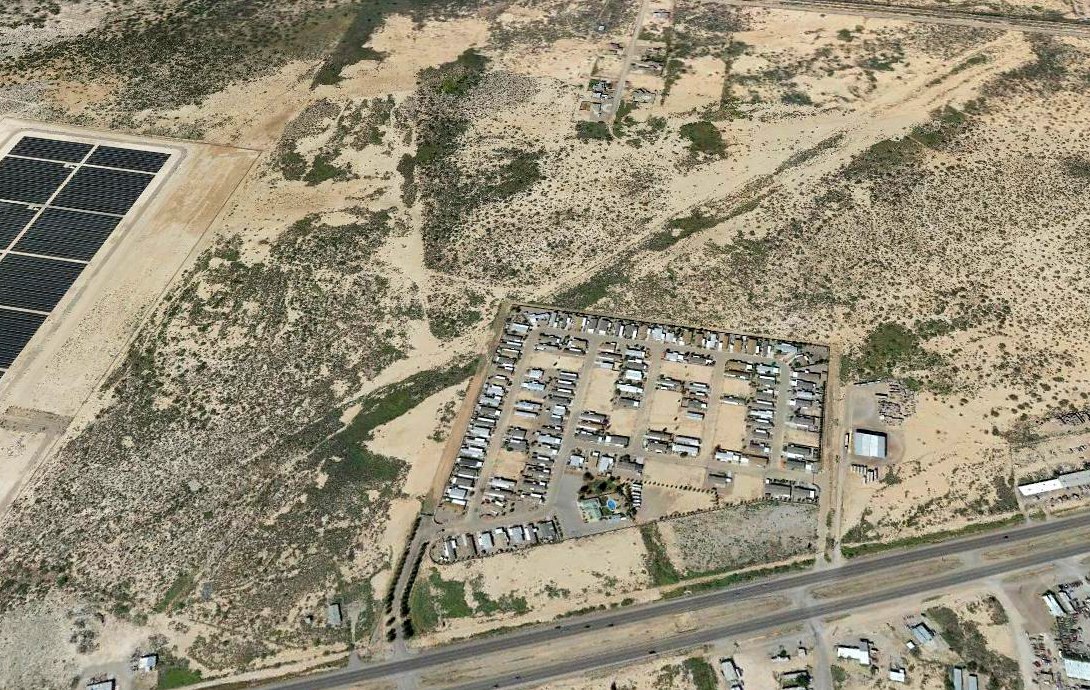
A 2013 aerial view looking northwest at the Alamo Midway Airport site, showing the trailer park which was built at some point between 1996-2006 over the midpoint of Runway 3/21.
The site of Midway Airport is located north of the intersection of Route 70 & Airport Road,
only one mile north of Alamogordo - White Sands Regional Airport.
______________________________________________________
Oscura Army Airfield, Oscura, NM
33.49, -106.184 (South of Albuquerque, NM)
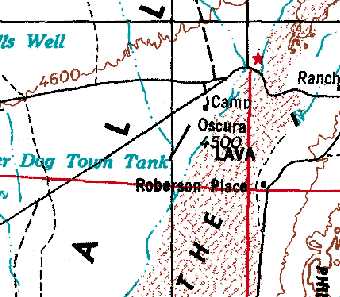
Oscura AAF, as depicted on the 1962 USGS topo map.
Photo of the airfield while operational has not been located.
The Army's huge White Sands Proving Grounds was established in 1945,
and has been used to test nearly every missile system in the US inventory
(as well as being the location of the original atomic bomb detonations).
White Sands is the largest military installation in the US, encompassing more than 4,000 square miles.
Oscura Army Airfield is is located on the northeast corner of White Sands, and is one of several airfields within the Proving Grounds.
The date of construction of Oscura AAF is unknown, as well as its specific purpose in supporting the testing activities conducted at White Sands.
It was apparently built at some point between 1947-62, as it was not listed among active airfields in the 1945 AAF Airfield Directory (courtesy of Scott Murdock)
nor depicted on the 1947 USGS topo map.
Mike Marson recalled, “Tom Marson was Civil Air Patrol in that area of the country in the mid 1950s to 1960.
He was a flight instructor, and worked as a civilian engineer for the DoD at White Sands.
He tells me the Oscura field was used by White Sands Missile Range to fly planes out of in advance of live fire tests of missiles
to look for & warn off civilians who might be on horseback or off-road vehicles in the test area.”
The earliest depiction of Oscura AAF which has been located is the 1962 USGS topo map.
The Oscura airfield was not depicted on the March 1963 Roswell Sectional Chart (according to Chris Kennedy),
but did appear on the June 1964 Roswell Sectional Chart (according to Chris Kennedy).
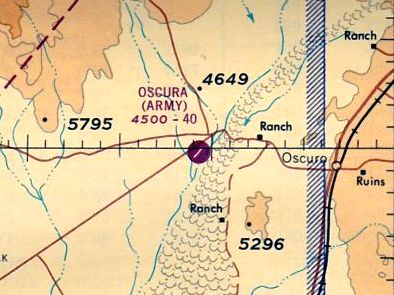
The June 1965 Roswell Sectional Chart (courtesy of Ron Kunse)
depicted “Oscura (Army)” as having a 4,000' paved northeast/southwest runway.
The 1966 Roswell Sectional Chart (courtesy of John Voss)
depicted Oscura AAF as having a single 4,000' paved runway.
"Oscura (Army)" was still depicted as an active airfield
on the December 1968 Albuquerque Sectional Chart (courtesy of Chris Kennedy).

The earliest photo which has been located of Oscura AAF was an 8/3/73 USGS aerial view.
It depicted Oscura AAF as having a paved northeast/southwest runway with a small paved ramp on the northeastern corner.
There did not appear to be any hangars or other buildings directly associated with the airfield.
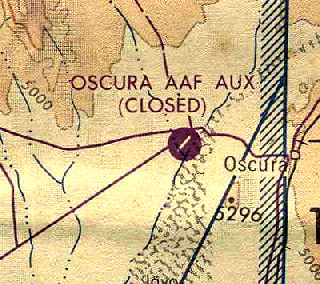
Oscura AAF apparently was closed (for reasons unknown) sometime between 1968-77,
as that is how it was depicted on the July 1977 World Aeronautical Chart (courtesy of Chris Kennedy).
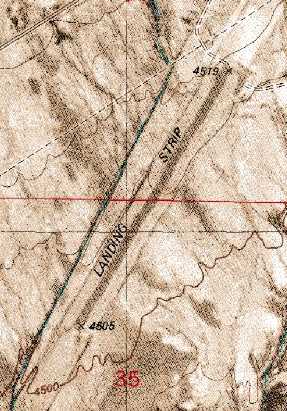
The 1994 USGS topo map depicted a single northeast/southwest runway at Oscura, but labeled simply as “Landing Strip”.

A 1996 USGS aerial view looking west at Oscura AAF clearly showed closed runway "X" markings along both ends of the runway.
The runway otherwise still appeared to be in fine condition. A small paved ramp was located east of the northern runway end.

A 2013 aerial view looking west along the abandoned runway at Oscura AAF.
Oscura AAF is located 7 miles west of Oscuro, NM.
____________________________________________________
Since this site was first put on the web in 1999, its popularity has grown tremendously.
If the total quantity of material on this site is to continue to grow,
it will require ever-increasing funding to pay its expenses.
Therefore, I request financial contributions from site visitors,
to help defray the increasing costs of the site
and ensure that it continues to be available & to grow.
What would you pay for a good aviation magazine, or a good aviation book?
Please consider a donation of an equivalent amount, at the least.
This site is not supported by commercial advertising –
it is purely supported by donations.
If you enjoy the site, and would like to make a financial contribution,
you
may use a credit card via
![]() :
:
Please consider checking the box to make a monthly donatation.
For a mailing address to send a check, please contact me at: paulandterryfreeman@gmail.com
If you enjoy this web site, please support it with a financial contribution.
please contact me at: paulandterryfreeman@gmail.com
If you enjoy this web site, please support it with a financial contribution.
____________________________________________________
This site covers airfields in all 50 states.